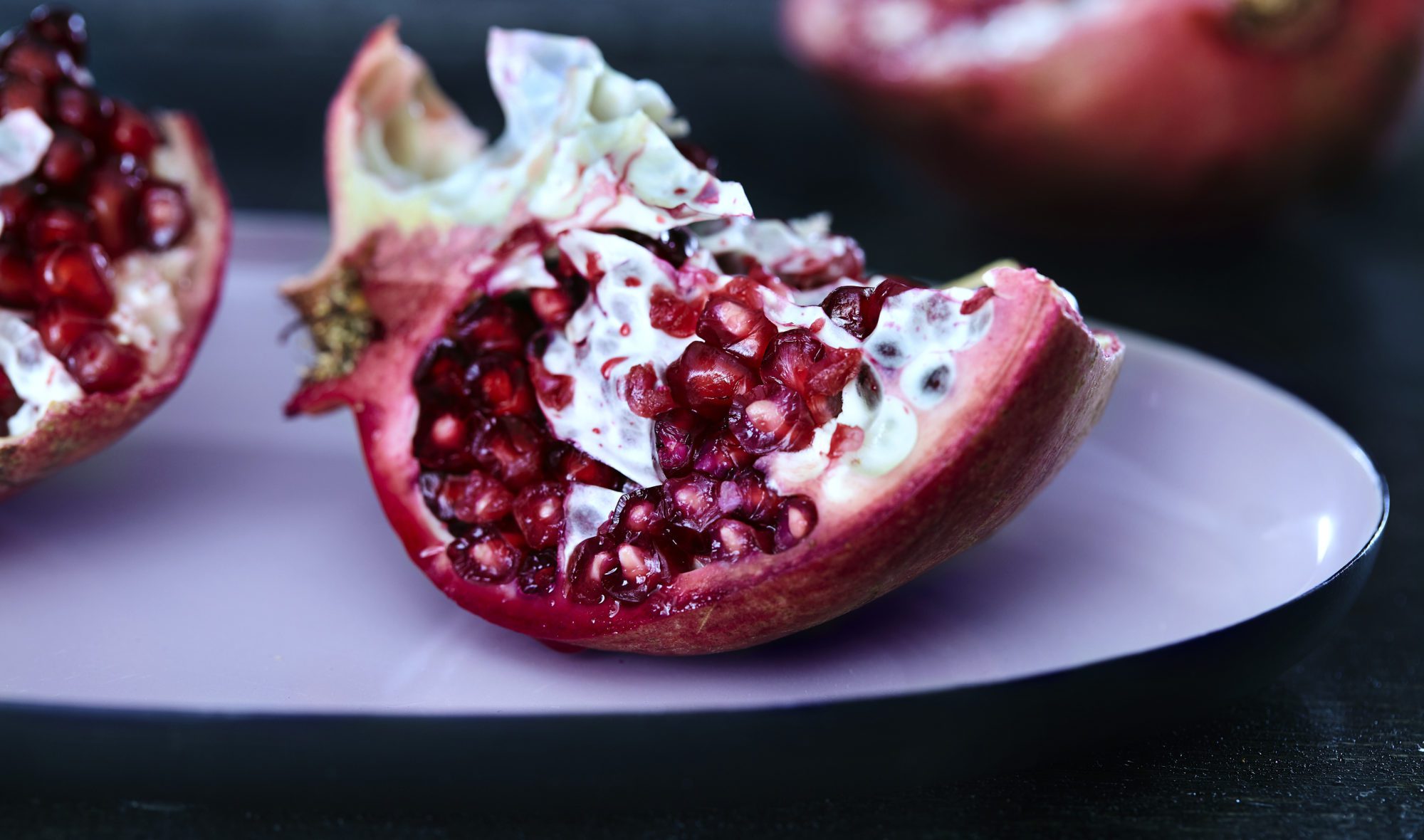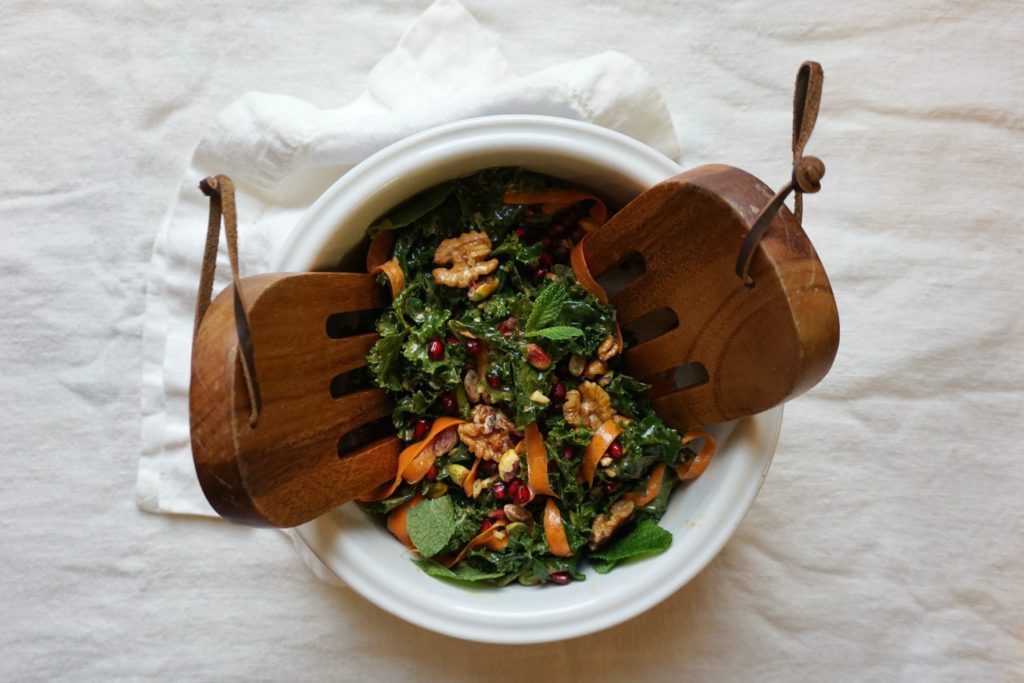
💥 Lowest price possible: on the Nutrition Coach Starter Package. Limited # left.

Pomegranates, beautiful and exotic with their jewel-like seeds, are also delicious, if not a little hard to eat. Depending on your level of patience and grace, you can either gently separate the arils from the skin and membranes, preferably underwater to avoid trauma or mess, or you can just rip it open and whack it indiscriminately against a hard object until the seeds fall out. These seeds, which look like rubies and taste like cherries, are a good source of vitamin C and a rich source of a unique antioxidant called punicalagin. Punicalagins are likely responsible for many of the health benefits attributed to pomegranates, and although the research on this compound is still in its preliminary phases, the evidence continues to grow that pomegranates are among the healthiest fruits in the world.
Like most jewels, the garnet-colored arils of the pomegranate must be mined with effort and delicacy.
The skin can be scored and peeled back gently, where the arils can be loosened with careful fingers into a bowl, or sectioned and immersed in a cool bath of water and swished around until the seeds loosen on their own volition.
Or, caveman-like, just slice the fruit coarsely in half and then whack it repeatedly with a blunt object until most of the seeds fly out.
The right way to way to eat a pomegranate is the subject of much debate.
Also the subject of much debate: the myriad of health claims relating to the pomegranate.
In recent years, the pomegranate has been promoted as a panacea for many health conditions, from prostate cancer, to erectile dysfunction, to cardiovascular disease. Much of this hype was promoted by a pomegranate juice company, which has since been ordered by the Federal Trade Commission to remove these claims.
In reality, the research on pomegranates, especially using human subjects, is still in its preliminary stages.
That being said, pomegranate is likely one of the healthiest fruits available to us. This is largely due to its high content of punicalagin, an antioxidant whose value beats that of antioxidant heavy-hitters like green tea and red wine.
The pomegranate is native to Iran and grows widely throughout the Middle East, India, and the Mediterranean regions. In North America, pomegranates are often expensive and frequently unavailable, making them a rather precious delicacy.
Pomegranates are beautiful as well as delicious and are often used purely for ornamental purposes as well as culinary purposes.
On the outside, pomegranates look a little bit like an apple, except they are topped with a blossoming peaked crown on one end. Their blushing red skin is tough but smooth, almost like leather, and although the skin contains a high concentration of nutrients, it is not generally eaten because of its coarse texture and bitter taste.
Peel the skin back and you will discover chambers of jewel-like arils, separated by translucent white membranes. The arils, which cluster tightly together, are ruby-colored juice-filled sacs, each harboring a tiny white, edible seed.
When eaten, the arils burst easily in the mouth to release a punchy, slightly tannic, sweet juice, similar in flavor to cherries. The seeds, which are nearly flavorless, add nothing but a crunchy texture.
Half a cup of pomegranate arils (about 87g) has 72 calories, 1.5g of protein, 1.0g of fat, 16.3g of carbohydrates, 3.5g of fiber, and 11.9g of sugar. Pomegranates are a good source of vitamin C.
Perhaps more interesting, nutritionally speaking, is the antioxidant content of pomegranates. Pomegranates contain a class of powerful antioxidant phytochemicals called punicalagins. Punicalagins, which are thought to be stronger than even the antioxidants found in green tea and red wine, are responsible for many of the health benefits of pomegranates.
Fresh pomegranates are most likely available in North America between September and January, and may only be found in larger grocery stores or specialty food shops.
Occasionally, you may find the fresh arils sold in containers, ready to eat.
Additionally, pomegranate arils may be found dried, either whole or ground, and sold as a spice in Indian or Pakistani grocery stores or specialty spice shops.
When purchasing fresh pomegranates, choose specimens that are firm, deeply colored (their color can range from deep red to reddish-brown), and heavy for their size – those will be the juiciest. Pass over pomegranates that have darkened soft spots or feel very light.
Pomegranates store well and can stay fresh in the fridge for 3-8 weeks, depending on the age of the fruit when purchased.
Pomegranate arils can also be frozen in sealed bags, where they will keep for up to six months.
Although there are many ways to prepare a pomegranate, arguably the easiest and least messy way is the following method:

Hearty kale leaves are massaged until tender, dressed with a spicy-sweet harissa dressing, sprinkled with fresh mint, and topped with crunchy nuts and juicy pomegranate seeds.
Prep Time: 20 minutes Cook Time: 0 minutes Yield: 2 servings
For the dressing:
First, make the dressing: Add olive oil, yogurt, vinegar, maple syrup, harissa, garlic, and salt to a jar and whisk until emulsified. Set aside as you prepare the salad.
For the salad:
In a large bowl, place de-stemmed kale leaves and, using clean hands, begin to massage them. Do this for a minute or two, or until leaves are floppy and softened. To this same bowl, add carrot ribbons, pomegranate seeds, mint leaves, walnuts, pistachios, and dressing. Toss to coat, and serve immediately.
Precision Nutrition’s Encyclopedia of Food expands every single month as we highlight new foods and showcase beautiful food photography. If you’d like to stay up to date, simply click this link. From there, we’ll send you a FREE copy of our recipe book. We’ll also let you know when new and delicious foods are added to the site.
Pomegranates, beautiful and exotic with their jewel-like seeds, are also delicious, if not a little hard to eat. Depending on your level of patience and grace, you can either gently separate the arils from the skin and membranes, preferably underwater to avoid trauma or mess, or you can just rip it open and whack it indiscriminately against a hard object until the seeds fall out. These seeds, which look like rubies and taste like cherries, are a good source of vitamin C and a rich source of a unique antioxidant called punicalagin. Punicalagins are likely responsible for many of the health benefits attributed to pomegranates, and although the research on this compound is still in its preliminary phases, the evidence continues to grow that pomegranates are among the healthiest fruits in the world.